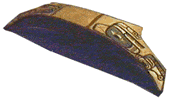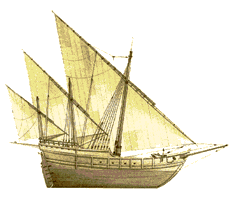 A
NCIENT TIMES -
14
TH
C
ENTURY
A
NCIENT TIMES -
14
TH
C
ENTURY

 A
NCIENT TIMES -
14
TH
C
ENTURY
A
NCIENT TIMES -
14
TH
C
ENTURY

 ravelers of the ancient world explored distant regions not only out of necessity for such things as food and shelter but also out of sheer curiosity. A
wide range of water craft designs
were used by ancient travelers, enabling peoples from different lands to meet and communicate. With the growth of populations in areas defined today as countries, and the formation of systems to govern these populations, it became necessary to acquire more land and resources in order to gain power and compete in the world market.
Trade
soon became the key motivating factor for exploration while the advancement of shipbuilding techniques allowed for exploration at farther distances and for longer duration.
ravelers of the ancient world explored distant regions not only out of necessity for such things as food and shelter but also out of sheer curiosity. A
wide range of water craft designs
were used by ancient travelers, enabling peoples from different lands to meet and communicate. With the growth of populations in areas defined today as countries, and the formation of systems to govern these populations, it became necessary to acquire more land and resources in order to gain power and compete in the world market.
Trade
soon became the key motivating factor for exploration while the advancement of shipbuilding techniques allowed for exploration at farther distances and for longer duration.
|
 Haida canoe mmbc1511 |
||
 Arab dhow |
By the 8th century, Arab language, knowledge and the religion of Islam had spread across vast distances. Muslim scholars (those who followed Islam) sought out scientific knowledge when exploring other lands. These scholars were first to calculate that the earth was round. Excelling in navigation, they are credited with the invention of the astrolabe. The best known Muslim traveler is Ibn Battuta who wrote about his adventurous 14th century journeys by sea and land in a book titled "Travels". | ||
| The Vikings, namely Norse explorers Bjarni Herjulfsson, Eric the Red, and son Leif Erikson, discovered Iceland, Greenland, and the coastline as far south as the northeastern American states in the late tenth century. It would be several centuries before other European peoples explored the Americas. |
 A Norse ship |
||
In the 13th century the Mongols, under the command of Ghengis Khan, opened up the overland silk and spice trade routes between Europe and China that had previously been blocked by Islamic countries, allowing for easier overland trade. Access by sea made trade even faster. At this time Marco Polo and his brother Niccolo set out from Venice on a land and sea expedition to modern day China. For 20 years Marco worked within Kublai Khan's (Ghengis' grandson) empire, later recording his adventures. By the 14th century trade between Europe, Africa, the Middle East, and China was flourishing with the demand for
silk, gold, salt, and spices.
|
|||
 15
TH -
17
TH
C
ENTURY
15
TH -
17
TH
C
ENTURY

| The 15th century marked the Great Age of European exploration. The Portuguese, drawn by tales of gold in West Africa and prompted by an Ottoman Turk blockade of overland trade routes, ventured south along the African coast and sailed around the tip of Africa with the aim of discovering a sea route to India and Asia. The use of vessels called caravels enabled the Portuguese to undergo such daring sea travel. Diogo Cão, Bartolomeu Dias and Vasco da Gama were three prominent Portuguese explorers. |  Portugese caravel |
||
 Columbus |
By the late 15th century, the European notion that the world was flat was gradually being dismissed. Christopher Columbus, an Italian financed by the Spanish, believed the earth was round and that a better sea route to Asia and the Spice Islands (Indonesian and Philippine Islands) could therefore be found by sailing west across the Atlantic. Columbus made four voyages, the first of which began in 1492 in the Nina, the Pinta, and the Santa Maria. Instead of Asia, Columbus discovered the West Indies, and Central and South America. This 'New World' was soon to be visited by the Spanish. | ||
| In 1519 the Spanish king financed an expedition for Portuguese explorer Ferdinand Magellan to command an expedition to sail west to the Spice Islands in search of a shorter passage. On this voyage of three years, Magellan, sailing in the Victoria, rounded the tip of South America by way of the strait now named after him, and into the more peaceful body of water known as the Pacific Ocean. During this expedition Magellan was killed in the Philippines, however, Juan Sebastian Elcano continued in the Victoria, returning to Spain and completing the circumnavigation of the world. The next explorer to circumnavigate the world was Englishman Sir Francis Drake in 1580. | |||
 North America ca. 1700 |
Two new routes by sea to the Far East had now been discovered: the Portuguese had sailed east around Africa, and the Spanish had sailed west around South America. Both journeys were long, difficult and dangerous. Voyages such as Drake's, which reached the northwest coast of America, caused Europeans to consider the possibility that an improved route might exist through the northern part of America.
By the 16th and 17th centuries European explorers such as Frenchmen, Jacques Cartier and Samuel de Champlain, following this new theory, had made discoveries in the St. Lawrence Seaway area of 'New France' in eastern Canada. The search for a body of water linking the Atlantic to the Pacific was not successful, however, the thriving fur trade in this region gave new reasons for establishing interests in North America rather than bypassing it enroute to Asia and the Spice Islands. |
||
| On the west coast, European exploration into the Pacific increased steadily. Hernando Cortes and Francisco Pizarro laid Spanish claim to Mexico and Peru early in the 16th century. Drawn by stories of gold and other treasures, these explorers, referred to as 'conquistadores' or conquerers, enabled Spain to become very wealthy. Spain quickly began to utilize the rich resources that were present in these New World regions, establishing settlements and a system of colonial rule. These settlements formed the base from which further exploration could continue. |
 Aztec gold figure |
||
| Russia, Spain, England, and France became the main competitors on the northwest coast of America. Understandably, in addition to the search for the northwest passage, each of these countries was interested in establishing claim to the newly discovered lands. In the push for the expansion of their empires, each country saw not only the resource potential that these new lands offered, but also the opportunities that existed for colonization. | |||
 18
TH
C
ENTURY
18
TH
C
ENTURY

In the 18th century exploration was motivated by the same desires. Captain James Cook, credited as the first European to set foot on the northwest coast of Canada (in 1778), was sent on three British expeditions to the Pacific to discover new lands and conduct scientific research. Two main concerns for the British were to confirm the existence of 'Terra Australis Incognita', the great land mass said to exist in the southern hemisphere, and to find the 'Strait of Anian', known also as the northwest passage. Looking to profit from the resources that were believed to exist on the vast southern continent, and to secure an improved sea route to the Far East, Britain soon learned that all was not exactly as imagined. In the process, great scientific discoveries were made in areas such as astronomy, botany and ethnology. By the time it was confirmed that the northwest passage did not exist (see Vancouver), several merchants had established trading relations with the First Nations peoples of the northwest coast.

![[English]](../simages/english.gif)
|

![[French]](../simages/french.gif)
|

![[Credits]](../simages/credit.gif)
|

![[Feedback]](../simages/feedback.gif)
|